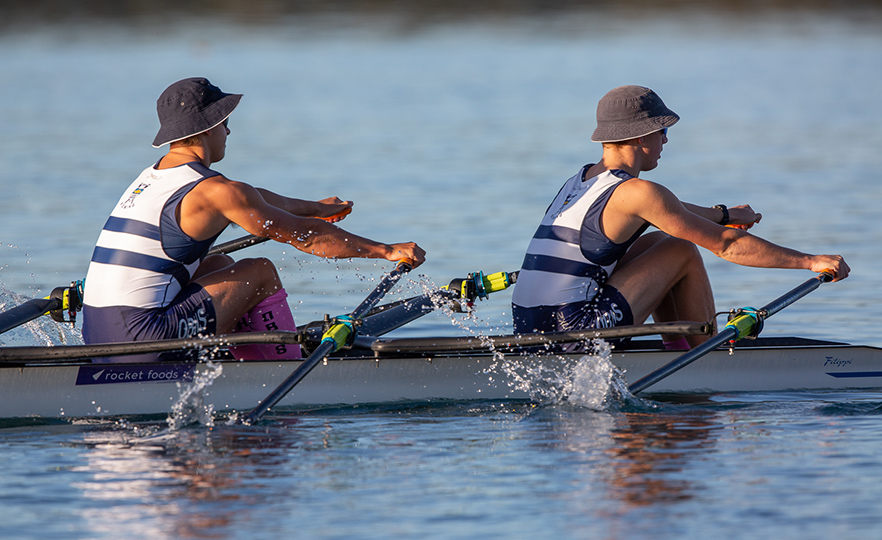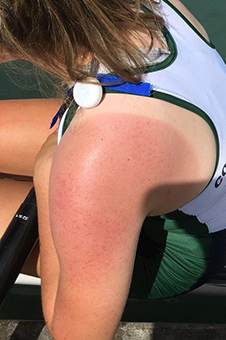
Rowers shown wearing sun protective headwear and sunglasses as recommended by the University of Otago study. Photo: Sharron Bennett.
High school rowing uniforms should include sun protective headwear and sunglasses to better shield rowers from the harmful effects of the sun, a University of Otago study recommends.
Master's student Linda Buxton's study of young rowers at Lake Ruataniwha found they could be exposed to dangerous levels of solar radiation during regattas.
“While on the water competing in one race, 67 per cent of athletes exceeded the daily recommended UVR (ultraviolet radiation) dose. As athletes usually compete in more than one race per day and are also exposed to UVR between races, overall UVR exposure is likely to be extremely high,” Ms Buxton says.
The UVR exposure during one quarter of the race-times measured was high enough to cause sunburn in people with light coloured skin. A race-time is the period when the boat is on the water, including moving to and from the start and finish line.
About 20 per cent of the rowers wore no head protection and younger rowers were less likely to cover their heads.
The study recommends that school rowing uniform regulations include the wearing of sunglasses and sun protective headwear such as bucket hats and peaked caps, which afford some protection to the face and do not impact performance.
Sun protection should be used routinely at rowing regattas even when the UV index (UVI) is below three because of the length of time athletes are outside over the duration of a regatta. Usually, sun protection is recommended when the UVI is three or greater.
Ms Buxton has worked for the Cancer Society in skin cancer prevention for the past 10 years and led the study for her master's with the Social and Behavioural Research Unit in the University of Otago's Department of Preventive and Social Medicine. The paper has been published in the Journal of Photochemistry and Photobiology B: Biology.
The research stemmed from her daughter's involvement in rowing and the observation that regattas are “a really hard place to avoid getting sunburnt”.
She worked with the rowing community and Rowing New Zealand which has been very supportive of the work.
“The teenagers themselves were very cooperative. It was a very positive experience.”

A rower with dosimeter in place to measure UVR exposure. The damage to skin and eyes accumulates over a person's life span. In high UVR environments like at rowing it is easy to get sunburnt. Sunscreen applied properly helps to protect skin left exposed by the sports uniform during competitive sports.
High school rowers were fitted with personal dosimeters – instruments for measuring UVR – and data was collected over five regattas in consecutive summers at the South Island lake.
The data shows that rowing is a high UVR exposure sport with a single race-time of approximately 45 minutes able to cause sunburn in individuals with light coloured skin. The study notes that two of the regattas took place in cloudy weather and the UVR exposure rates would have been “considerably higher” if all the regattas occurred under clear sky conditions.
Ms Buxton says UV exposure was not only harmful when the sun was at its highest. During morning races, the rowers would be exposed to “scattered UVR” and sunlight reflected off the boat and the water. The low angle of the sun in the morning also made it more dangerous for the eyes.
Skin cancer is New Zealand's most common cancer and about 90 per cent of cases are caused by overexposure to UVR. The most common environmental cause of cataracts is also UVR.
She says preventing episodes of sunburn and UVR overexposure in young people is important to reduce the incidence of skin cancer later in life but very little research has been published on the UVR exposure of high school athletes.
“At the Cancer Society we're right at the beginning of working with sports organisations to try and help them to start to think about being sun-smart.”
The research notes that risk management is already a priority for organisers of sports events but that typically the focus is on immediate risks, such as water safety, traffic management and the potential for extreme weather events.
“The UVR exposure of high school rowers during competitive rowing justifies careful consideration of long-term risks, and a dedicated risk management response.”
Publication details
Erythemal ultraviolet radiation exposure of high school rowers in Aotearoa/New Zealand
Linda Buxton, Tony Reeder, Louise Marsh, Bronwen McNoe, Ella Iosua.
Journal of Photochemistry and Photobiology B: Biology
For further information, contact:
Linda Buxton
Tel +64 3 477 7447
Email linda.buxton@cansoc.org.nz
Find an Otago expert
Use our Media Expertise Database to find an Otago researcher for media comment.